Mohan Ramisetty, Suri A. Sastri and Lee Goldman, Surmet Corp.
Polycrystalline ceramics with the cubic spinel structure enable multiple defense applications, including night-vision goggles and IR optics for military systems such as domes, lenses, reconnaissance and sensor windows – they also have applications in nonmilitary arenas such as semiconductor processing, oil and gas drilling, medical optics and lasers.
Spinel ceramics have been around for a very long time, and ALON – a ceramic based on a composition of aluminum oxynitride with a cubic spinel crystal structure – has been around for over 50 years. However, until the late 1990s or so, the majority of research related to these materials stayed within the laboratories and academia. Commercialization efforts have taken the fast track in the recent 10 years or so. Thanks to growing interest and efforts from the defense and aerospace industries, both ALON and spinel now are commercially available in the US. This is expected to usher in multiple industrial and civilian applications that can benefit from the unique optical and mechanical properties of ALON and spinel. And these transparent ceramic materials have broad appeal to the precision optics community as well.
Several factors are driving the commercial development of ALON and spinel ceramics. At the top of the list are their extreme durability, their high-temperature performance and their superior mechanical properties over glasses, as well as their ease of scalability and manufacturability compared with single crystals such as sapphire. Being polycrystalline – as opposed to a single crystal – makes their fabrication into large and complex shapes using a variety of powder processing approaches easier. However, starting with powder and making it into a fully dense see-through ceramic involves multiple engineering challenges.
For any material to be transparent, the light must be transmitted through it without significant absorption and/or reflection losses. Unlike many glasses and single crystals, polycrystalline ceramics consist of complex microstructural features such as grains, grain boundaries, pores, defects and secondary phases or inclusions. Any or all of these could act as scattering sites, leading to absorption losses and rendering the material translucent or opaque. Since both ALON and spinel are cubic (and hence isotropic and nonbirefringent), scattering losses that occur at the grain boundaries as a result of crystalline orientation can be ignored. However, the other microstructural features, if present, could still cause scattering.
Controlled microstructure necessitates stringent control over processing, starting from powder synthesis all the way through to densification. Spinel powder is only available in a large quantity from a supplier in France, while ALON is synthesized in the US by Surmet Corp. in tonnage quantities for its own use. While ALON is produced via the sinter/hot isostatic pressing (HIP) process, spinel components can be made via both sinter/HIP and hot press/HIP processes. For the hot-press process, spinel must be “doped” with lithium fluoride, which acts as a liquid-phase sintering aid. Either way, processing spinel is a challenge, as inclusions and haze in the finished piece reduce yield and acceptability; years of development efforts have not completely resolved these issues. The lithium-fluoride-doped, hot-pressed spinel suffers from grain-boundary brittleness and also edge chipping during final grinding and polishing.
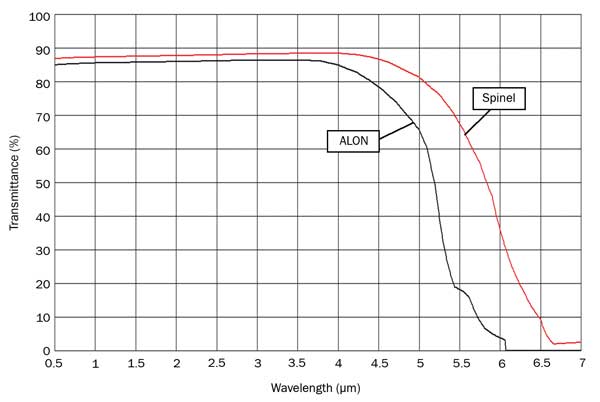
Figure 1. Typical optical transmittance of ALON and spinel at 2-mm thickness (without antireflection coatings).
Optical properties of ceramics
Both ALON and spinel are transparent in the near-UV, visible and mid-IR wavelength regions.
Figure 1 shows calculated optical transmittance of ALON and spinel at 2-mm thickness. Spinel is preferred over ALON mostly in applications where high transmission is required in the 4- to 5-µm wavelength range. Even here, allowance must be made for the optical quality issues such as inclusion and haze that are part of the spinel makeup. ALON components generally do not have such defects and are not prone to grain-boundary weakness. Additionally, ALON products generally have high optical clarity (>95 percent), low haze (<2 percent) and high homogeneity. (Clarity is a function of low-angle scattering; haze is from wide-angle scattering.) Table 1 shows some of the optical properties of ALON and spinel optical ceramics.
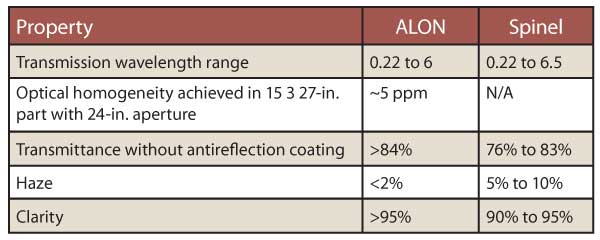
Table 1. Important optical properties of ALON optical and spinel ceramics. *Varies depending on thickness and processing conditions. Transmission, haze and clarity values are for visible wavelengths.
The transmission wavelength range is inherent to the material. Transmission in the UV and visible is dependent on a material’s bandgap, whereas bond strength and ionic radii determine IR transmission. However, transmission (relative to theoretical limit, which is a function of refractive index), haze and clarity values are determined by microstructural aspects such as pores, secondary phases, inhomogeneities at the grain boundaries, etc. Low haze and high clarity mean that a material is free of any such scattering sites.
In addition to providing excellent optical transmission in visible and mid-IR wavelengths, both ALON and spinel hold interesting dispersion behavior. Dispersion is the change in refractive index with the wavelength, typically denoted by Abbe number. Figure 2 shows that both these materials have an Abbe number of about 60, lower than many glasses. Lower dispersion facilitates lower chromatic aberration when the material is made into lenses.
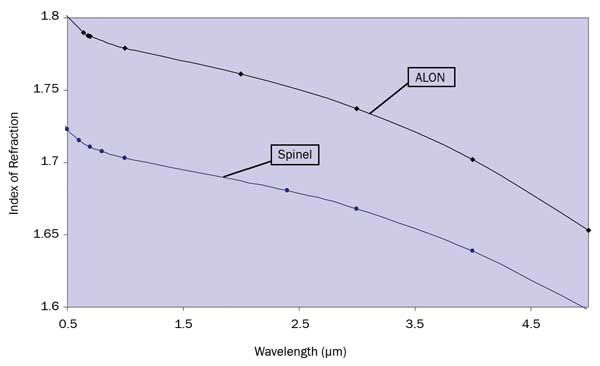 Figure 2. Dispersion in ALON and spinel ceramics. Both materials have an Abbe number of about 60, lower than many glasses.
Figure 2. Dispersion in ALON and spinel ceramics. Both materials have an Abbe number of about 60, lower than many glasses.
Moreover, ALON’s refractive index or dispersion curve can be modified or shifted by either adjusting the composition or by doping without affecting its transparency. This is a unique functionality that opens up many new opportunities for this material in optics. One example of such applications is gradient refractive index (GRIN) lenses.
GRIN lenses are advanced optics in which the lens curvature can be built into a flat lens by varying the refractive index within the lens, thus eliminating or minimizing the complexity, size and weight of the system – which significantly improves the performance.
Transparency in the mid-IR also makes ALON suitable for night-vision goggle systems (NVG). NVGs are typically used for improved transmission under low-light conditions and require transmission at wavelengths between 0.4 and 0.92 µm. In many transparent-armor and other window applications, ALON-based NVGs offer better optical transmission in these wavelengths than many glasses. Better transmission means improved awareness to the user because of increased signal-to-noise ratio.
Transparent armor
Figure 3 shows that ALON transparent armor laminates exhibit multihit ballistic performance against armor-piercing threats of up to 50 caliber at half the weight and thickness of glass-based armor. ALON’s high hardness and high modulus provide a significant advantage in eroding and destroying the projectile (shown in the Figure 3 inset) over glass and other materials, including spinel. ALON-based transparent armor systems are currently being tested for many defense applications, including ground vehicles such as Humvees and mine-resistant, ambush-protected vehicles, and also aircraft.
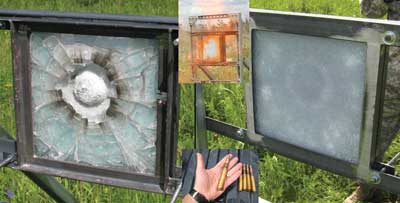
Figure 3. Testing ALON transparent armor: photographs of ALON laminates after 50-caliber live-fire testing showing no penetration. The left image shows the front, and the right image shows the rear. The 50-caliber bullets and frame capture at the time of firing are shown in the insets.
Infrared optics
Many IR optics systems for defense exploit the IR transmission properties of both ALON and spinel. Some of these applications require windows, domes, lenses, etc. Unlike single-crystal materials, ALON and spinel components can be made into any shape and size using ceramic powder mold processing techniques.
• Domes and lenses: As shown in Figure 4, hemispherical and hyperhemispherical domes made from both ALON and spinel are being evaluated for many defense IR-guided-missile optics systems. ALON tri-mode seeker dome (Figure 4d) is being tested on joint air-to-ground missile systems. Common IR countermeasure systems are another potential application for ALON hyperhemispherical domes. Spinel lenses (Figure 4b) are currently being used for aircraft-based targeting pod systems.
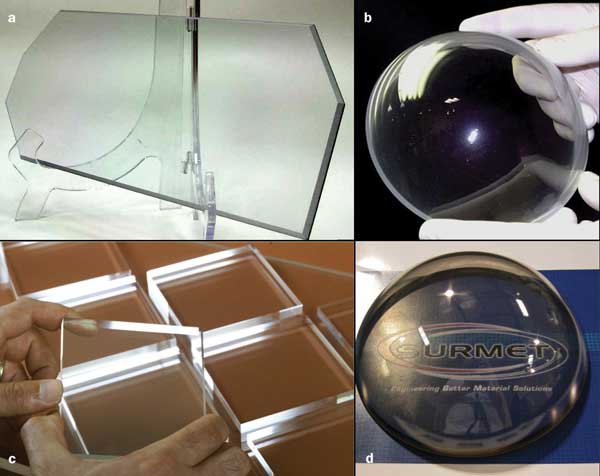
Figure 4. Examples of ALON and spinel components manufactured by Surmet.
• Reconnaissance and sensor windows: Reconnaissance systems require extremely stringent optical specifications such as refractive index homogeneity and transmitted wavefront error, and the window sizes are normally about 15 x 25 in. (Figure 4a). Manufacturing transparent polycrystalline ceramic into such large sizes is itself a separate challenge, and doing so to very high optical quality specifications is quite a task. But ALON windows have already been installed into helicopter-based sensors, and spinel has been used in aircraft-targeting pod systems in the military. As shown in Figure 5, large windows of 15 x 27 in. with a very low refractive index inhomogeneity of about 4 to 5 ppm (root mean square over the entire window area) can be made from ALON.
• Night-vision goggles: Many transparent armor systems used on ground vehicles as well as aircraft require night-vision transmittance to provide situational awareness to the soldier. ALON-based transparent armor systems have been shown to provide 40 to 50 percent improvement in NVG performance over glass-based armor for Gen III systems. Though glass-based armor meets current NVG specifications, there is increased emphasis on performance of next-generation NVGs, and ALON is being considered.
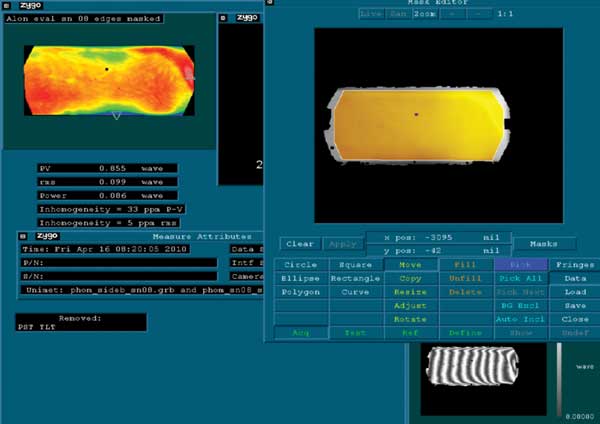
Figure 5. Refractive index homogeneity measurements of a 15 x 27-in. ALON window measured using a 24-in.-aperture interferometer. Applications for such a component include reconnaissance and sensor windows.
• GRIN optics: This advanced technology of producing components with controlled gradient index is still in development. Potential applications at this point are in the military, but given the advantages such as light weight, extreme durability, night-vision capability, and possibility of flat and less-complex lens systems, there may be other nondefense applications that could greatly benefit from using ALON-based GRIN optics.
• Windows for laser-based communications: Transparent ceramics such as ALON also could be of use for defense laser systems requiring protection from the field and high transmittance so that there is no obstruction to the light that is transmitted.
The future of transparent ceramics
With funding support from the US Department of Defense and its own resources, Surmet has successfully fabricated several 18 x 35-in. monolithic ALON windows. One of those windows is shown in Figure 6. These are the largest transparent polycrystalline ceramic armor windows ever made.
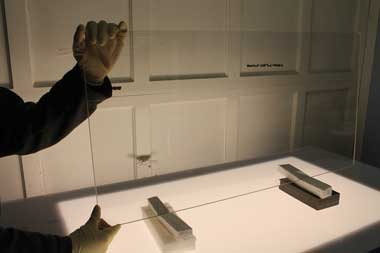
Figure 6. This 18 x 35-in. ALON window is possibly the biggest transparent ceramic window ever made.
Successful large-scale commercial availability of these materials at low costs will require high-volume manufacturing, which in turn will require high-volume market pull. The volumes required by the defense industry are not sufficient at this time to warrant setting up large-scale manufacturing. For volumes to increase, and for scaling up to be justified, these materials must find their way into both military and nonmilitary markets.
Meet the authors
Mohan Ramisetty is a member of the Advanced Materials Development Group at Surmet Corp. in Burlington, Mass.; email: [email protected]. Dr. Suri A. Sastri is the founder, chair and CEO at Surmet; email: [email protected]. Dr. Lee M. Goldman is the chief technical officer of the Optical Ceramics Div. at Surmet; email: [email protected]. The authors would like to acknowledge Uday Kashalikar, Taylor Bashaw, Sreeram Balasubramanian and Santosh Jha, who also contributed to the contents of this article.
References
1. Mohan Ramisetty et al (March 2013). Transparent polycrystalline cubic spinels protect and defend. American Ceramic Society Bulletin, Vol. 92, No. 2, pp. 20-25.
2. Army Materials Research (2004). Transforming Land Combat through New Technologies. AMPTIAC Quarterly, Vol. 8, No. 4.
3. Lee M. Goldman et al (May 2011). ALON optical ceramic transparencies for window, dome and transparent armor applications. Proceedings of SPIE, Vol. 8016.
4. Daniel C. Harris (June 1998). Durable 3-5 µm transmitting infrared window materials. Infrared Physics and Technology, Vol. 39, pp. 185-201.
5. Andreas Krell et al (January 2009). Transmission physics and consequences for materials selection, manufacturing, and applications. Journal of the European Ceramic Society, Vol. 29, pp. 207-221.